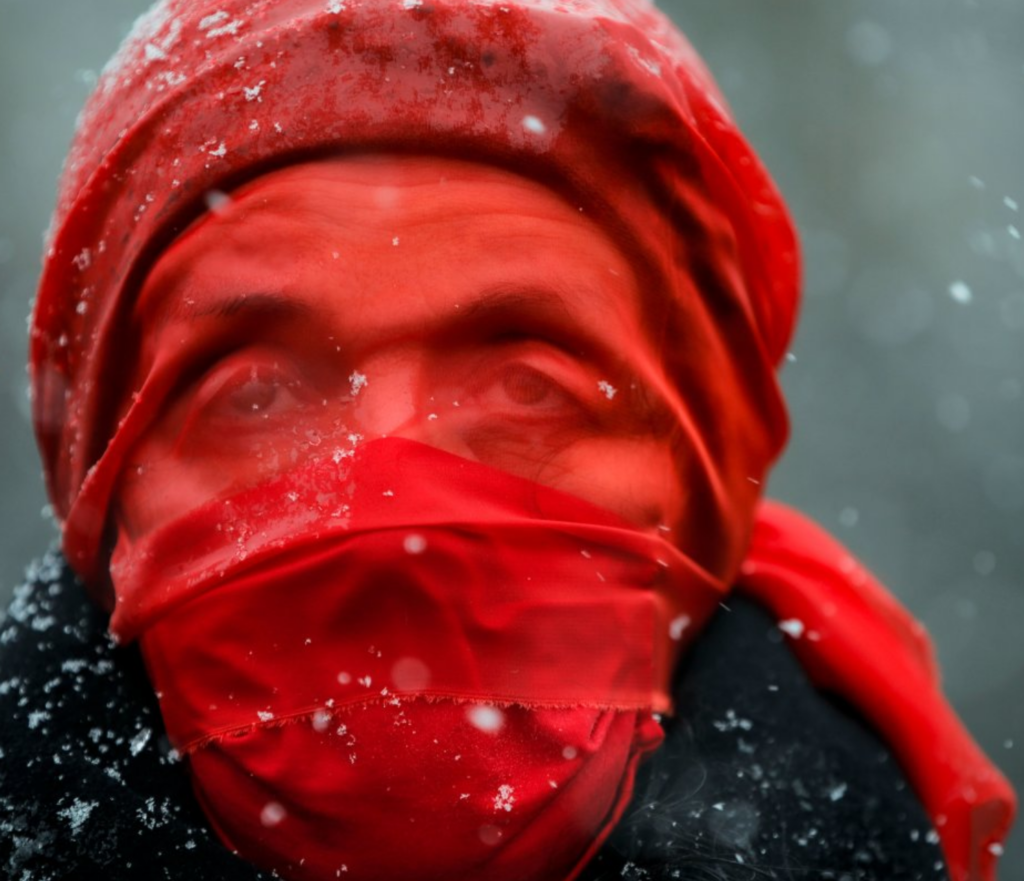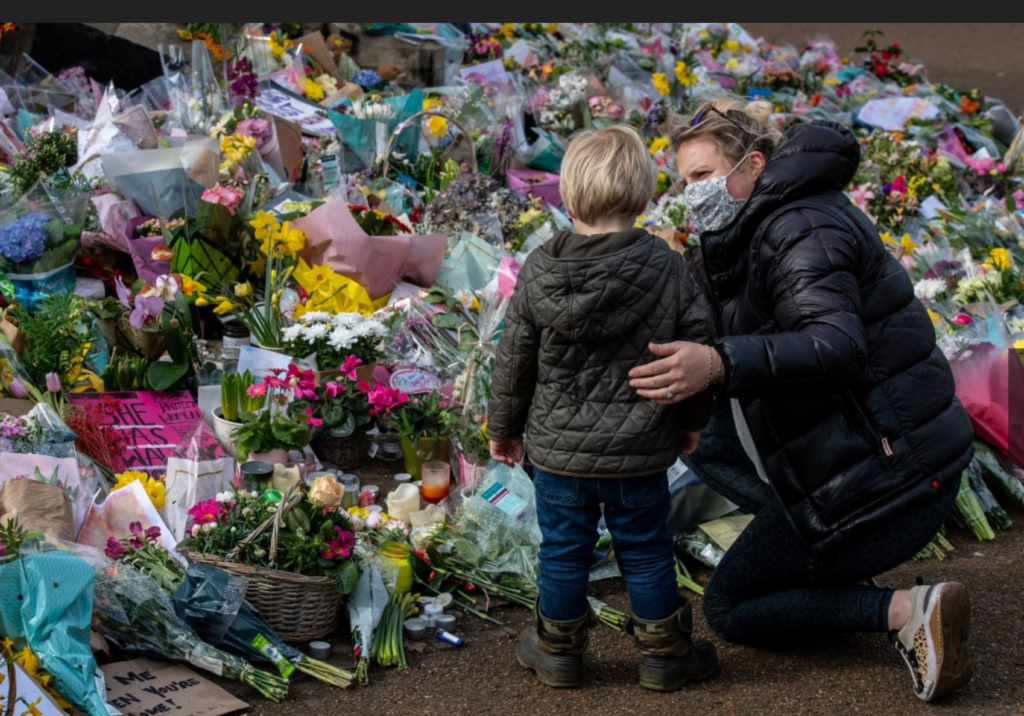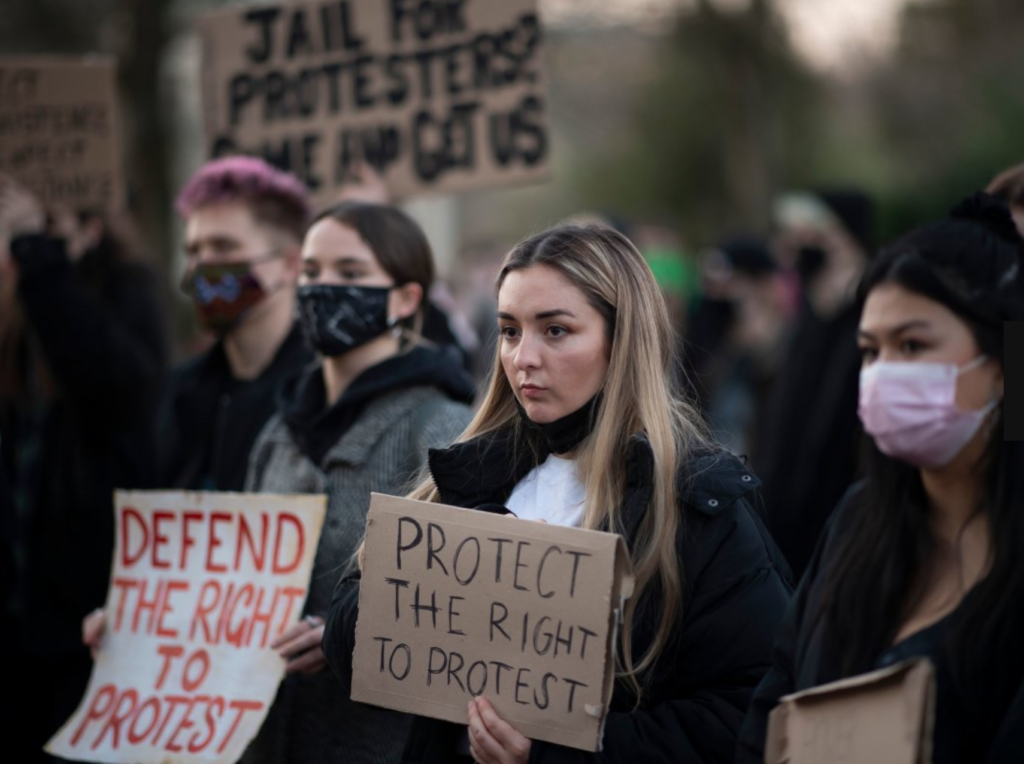
Photo: Vadim Ghirda/AP
March 10, 2021 | Bucharest, Romania |
A woman wears a red veil during a flashmob
to raise awareness of the increased levels of violence against women
since the COVID-19 pandemic started one year ago.

March 15, 2021 | London |
Flowers and messages are placed in tribute to Sarah Everard at Clapham Common.
Sarah Everard, a 33-year-old London resident whose kidnapping and death
– allegedly at the hands of an off-duty Metropolitan Police officer –
prompted a wave of concern over women’s safety.
The same police force is being criticized for its response
to the vigil, where they forcibly arrested several participants
for violations of pandemic-era rules on public assembly.

March 16, 2021 | London |
A parent takes their son to look at floral tributes left at Clapham Common
where people continue to pay their respects to Sarah Everard.

March 17, 2021 | Cardiff, Wales |
A woman holds a sign during a protest outside Cardiff Central Police Station.
Sarah Everard, 33, disappeared after walking home from a friend’s house on March 3.
Wayne Couzens, 48, has been charged with the 33-year-old’s kidnapping and murder.
Facts and Figures:
Ending Violence Against Women
https://www.unwomen.org/en/what-we-do/ending-violence-against-women/facts-and-figures
Availability of data on violence against women and girls has increased significantly in recent years, and data on the prevalence of intimate partner violence is now available for at least 106 countries. Visit our research and data page for more information on why data is critical to UN Women’s work supporting women and girls experiencing violence.
- Globally, 35 per cent of women have ever experienced physical and/or sexual intimate partner violence, or sexual violence by a non-partner. This figure does not include sexual harassment. Some national studies show that the number can be as high as 70 per cent of women, and that rates of depression, having an abortion, and acquiring HIV are higher in women who have experienced this type of violence compared to women who have not [1].
- Calls to helplines have increased five-fold in some countries as rates of reported intimate partner violence increase because of the COVID-19 pandemic. Restricted movement, social isolation, and economic insecurity are increasing women’s vulnerability to violence in the home around the world [2].
- By September 2020, 48 countries had integrated prevention and response to violence against women and girls into COVID-19 response plans, and 121 countries had adopted measures to strengthen services for women survivors of violence during the global crisis, but more efforts are urgently needed [3].
- 137 women are killed by a member of their family every day. It is estimated that of the 87,000 women who were intentionally killed in 2017 globally, more than half (50,000) were killed by intimate partners or family members. More than a third (30,000) of the women intentionally killed in 2017 were killed by their current or former intimate partner [4].
- Less than 40 per cent of the women who experience violence seek help of any sort. In the majority of countries with available data on this issue, among women who do seek help, most look to family and friends and very few look to formal institutions, such as police and health services. Less than 10 per cent of those seeking help appealed to the police [5].
- At least 155 countries have passed laws on domestic violence, and 140 have laws on sexual harassment in the workplace. However, even when laws exist, this does not mean they are always compliant with international standards and recommendations, or are implemented and enforced [6].
- Adult women account for nearly half (49 per cent) of all human trafficking victims detected globally. Women and girls together account for 72 per cent, with girls representing more than three out of every four child trafficking victims. Most women and girls are trafficked for the purpose of sexual exploitation [7].
- In 2019, one in five women, aged 20–24 years, were married before the age of 18. During the past decade, the global rate of child marriage has declined, with South Asia having the largest decline during this time. Today, the risk of child marriage is highest in sub-Saharan Africa, where more than one in three women, aged 20–24 years, were married before the age of 18. Child marriage often results in early pregnancy and social isolation, interrupts schooling, and increases a girl’s risk of experiencing domestic violence [8].
- At least 200 million women and girls, aged 15–49 years, have undergone female genital mutilation in 31 countries where the practice is concentrated. Half of these countries are in West Africa. There are still countries where female genital mutilation is almost universal, where at least 9 in 10 girls and women, aged 15–49 years, have been cut [9].
- 15 million adolescent girls worldwide, aged 15–19 years, have experienced forced sex. In the vast majority of countries, adolescent girls are most at risk of forced sex (forced sexual intercourse or other sexual acts) by a current or former husband, partner, or boyfriend. Based on data from 30 countries, only one per cent have ever sought professional help [10].
- School-related gender-based violence is a major obstacle to universal schooling and the right to education for girls. Globally, one in three students, aged 11–15, have been bullied by their peers at school at least once in the past month, with girls and boys equally likely to experience bullying. While boys are more likely to experience physical bullying than girls, girls are more likely to experience psychological bullying, and they report being made fun of because of how their face or body looks more frequently than boys [11].
- One in 10 women in the European Union report having experienced cyber-harassment since the age of 15. This included having received unwanted and/or offensive sexually explicit emails or SMS messages, or offensive and/or inappropriate advances on social networking sites. The risk is highest among young women aged 18–29 years [12].
- In the Middle East and North Africa, 40–60 per cent of women have experienced street-based sexual harassment. In the multi-country study, women said the harassment was mainly sexual comments, stalking or following, or staring or ogling. Between 31 and 64 per cent of men said they had carried out such acts. Younger men, men with more education, and men who experienced violence as children were more likely to engage in street sexual harassment [13].
- Across five regions, 82 per cent of women parliamentarians reported having experienced some form of psychological violence while serving their terms. This included remarks, gestures and images of a sexist or humiliating sexual nature, threats, and mobbing. Women cited social media as the main channel of this type of violence, and nearly half (44 per cent) reported receiving death, rape, assault, or abduction threats towards them or their families. Sixty-five per cent had been subjected to sexist remarks, primarily by male colleagues in parliament [14].
To find up-to-date data, visit UN Women’s Global Database on Violence against Women and the Women Count Data Hub.
Notes
[1] World Health Organization, Department of Reproductive Health and Research, London School of Hygiene and Tropical Medicine, South African Medical Research Council (2013). Global and regional estimates of violence against women: prevalence and health effects of intimate partner violence and non-partner sexual violence, p.2. For individual country information, see UN Women Global Database on Violence against Women.
Invoking St. Germaine and the Violet Flame
to end violence towards women.

Invoking the Mother to end violence against women
with her Blue Diamonds of Hope and Sanat Kumara for Balance on Gaia.


